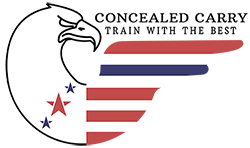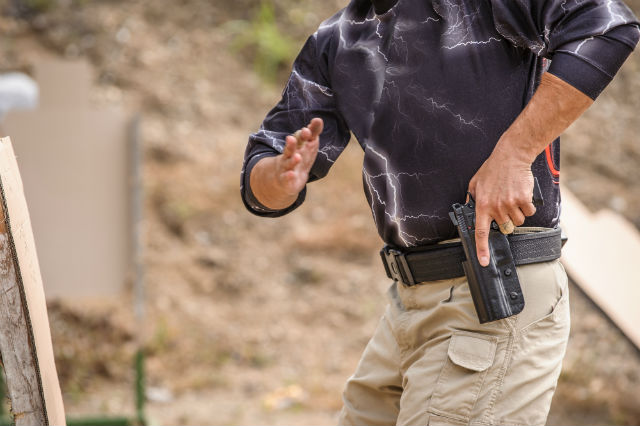Shooting Drills for Concealed Carry
Mastering concealed carry requires more than just owning a firearm—it demands regular training and practice. Effective shooting drills help improve accuracy, speed, and decision-making under pressure. Whether you’re a beginner or an experienced shooter, incorporating structured drills into your routine enhances your ability to respond confidently in self-defense situations. Here are five essential shooting drills designed to sharpen your skills and build confidence in carrying concealed.
First Drill: The wall Drill
One of the great dry fire drills is the most basic the Wall Drill. This drill was invented by George Harris, a former Sig Academy instructor. According to the man himself on US Concealed Carry, he came up it with while in the military. He called it the Wall Drill when he taught it to his students and the name stuck. The point of the drill isn’t the speed of draw or target acquisition per se, but rather developing trigger control, leading to muzzle control and thus greater accuracy.
The Wall Drill allows the shooter to dry fire in a manner that available maximum benefit in what should be seen with the eyes and felt with the hands to achieve a good shot. This is a great ‘daily drill’ or other activity that doesn’t require a round to leave the chamber but still hones the skills every concealed carrier needs to be successful in a defensive gun use situation. A wall drill can be a quick set of 5 or 10 repetitions or even 2 to 3 reps before you get ready to leave in the morning.
2nd Drill: Dry Fire Drill
These drills were originally created by David from Personal Defense Training in Atlanta, and we’ve had so many emails regarding them since we purchased the website, that I looked them up in the archives and am re-posting them here for everyone to continue to use. Dry firing is the simple act of using your unloaded firearm to practice a series of dry fire drills. At first glance,e it may appear that not much is being accomplished but the results are unbelievable. Most of these dry fire drills will end with the gun up and out with the front sight in focus.
Dry fire practice should only be conducted in one designated, established area, and nowhere else in your house. That area should have a safe wall, which is a wall that will actually stop bullets in the event of an unintended discharge. A brick exterior wall or a stone fireplace can work, or you can use a body armor vest as a backstop. Do not dry fire toward an interior drywall. Dry fire practice can be an important (and better yet, inexpensive) part of your training. And it’s convenient because you can do it in the comfort of your own home.
Let’s get started with some specific drills for you to conduct when engaging in live- and dry-fire practice. From dry-fire training at home to live-fire shooting drills on a traditional indoor range, or with a training partner at the local outdoor training center, let PDN Premium Membership help you make the most of your training time, money, and ammo! Try new gun shooting drills to safely find your balance of speed and precision.
3rd: THE Tactical Reload
It’s different from other reloading techniques such as the speed reload, which is where a person simply drops the previous magazine and inserts a new one as fast as possible. There are also a number of tactical reload drills out there, a few mirroring courses of fire from some pistol qualification courses.
The company that makes the target also has a range drill particularly designed around it. They call the drill the RE Factor Tactical Shooter Standard. Browse a few concealed carry forums, videos, and articles, and you’ll likely encounter some discussion about something known as the tactical reload. It is an actual reloading technique, so it doesn’t mean just reloading your gun while wearing special clothes.
4th Drill: The Double Tap
The Double Tap Drill incorporates all of them into one simple, easy-to-score drill. The double tap drill is considered by most to be two shots delivered to the target as quickly as possible. The double tap is an excellent tactic for maximizing wound potential. However, the benefit of the double tap is evident only if the double tap is properly delivered. First, realize that the double tap isn’t a flurry of shots. Two shots are delivered as quickly as you are able to acquire the sights after recoil and fire again. This means that each shot is a deliberate shot that is controlled.
The double tap is versatile and should be practiced first—before the controlled pair or the hammer. The hammer can be dangerous to the shooter if they have not mastered recoil control. It should be considered a short-range tactic. I have seen shooters deliver a double tap on a target with one bullet hole in the belt and another in the neck and deem it nice.
5th Drill: Simple Draw and Fire
This is a simple drill that builds on what’s crucial to carrying a defense gun, making the first shot. In a gunfight, the most important shot is the first one. If you can fire faster than your opponent and hit on target, your odds of winning increase substantially. Also be sure to practice this drill with your carry gun, wearing your normal concealment garment, like a jacket or vest. Start with having the gun exposed, then practice with it concealed.


